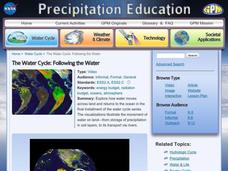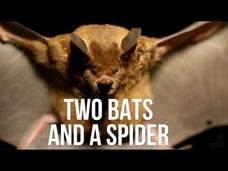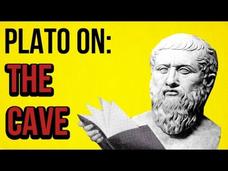NASA
The Water Cycle: Following the Water
Water that leaves the oceans must eventually return. The animations in the final lesson of the four-part NASA series show the complex path water can take across landforms before returning to the ocean. Approximately one-third of the...
FuseSchool
What Are Mendel and Genetic Crosses?
Darwin and others hypothesized evolution, but they never explained how it worked genetically. The video introduces Mendel and his hypothesis, which scientists have now proved. It explains how he created the hypothesis and what...
The Brain Scoop
Two Bats and a Spider
What creatures lurk in the rainforest at night? Meet three of them in one short video. Part of a playlist exploring mammals, the video presents a look at night research in the Amazon. Scientists locate and photograph two bat species and...
Curated OER
Trees
Trees are one of the most amazing life forms on the planet. Learn about the wonders, life cycles, and parts of trees. This is a beautiful and informative clip that will provide learners with a respect and understanding of why trees are...
Curated OER
Electricity From All Kinds of Renewable Sources
On a bold, computer-generated animation of a landscape appears a city, power plants, wind turbines, and smaller, decentralized combined heat and power (CHP) plants. The intent is to show how CHP plants can be incorporated into the energy...
FuseSchool
What Is Asexual Reproduction?
Nature clones plants and animals through asexual reproduction. The video explains what asexual reproduction is and the process involved. It highlights some of the plants, bacteria, and animals that use asexual reproduction. The video...
PBS
When The Earth Was Purple
Earth appears blue and green now, but an interesting video covers a theory about when our planet was purple. We know the sun emits mostly green light, so why do most plants repel green light rather than absorbing it? Did purple microbes...
Periodic Videos
Thorium
Is thorium the key to future nuclear power plants? This concept and more become the focus of video 90 in the 118-part series on chemical elements. The professor shares the properties of thorium as well as the future possibilities of a...
Crash Course
Biology Before Darwin: Crash Course History of Science #19
When did biology become a proper science? Travel back in time to the evolution of natural history during part 19 in an ongoing History of Science series. Pupils discover early pioneers in the study of plants and animals, the birth of...
Nature League
What Are Adaptations? - Lesson Plan
Texas short-horned lizards shoot blood out of their eyes to deter predators. The unique adaption allows them to thrive in a hostile environment. Pupils learn more about this and other adaptations of plants, animals, and humans in the...
Howard Hughes Medical Institute
Termite Activity Enhances Ecosystem Productivity and Stability
Termites in your house? Bad. Termites in your garden ... good? Discover the good side of an insect that often gets a bad rap with an interesting animation. The narrator discusses how termites break down plant material, what the soil...
Steve Spangler Science
Color Changing Carnations - Sick Science! #020
The classic carnation color-change activity for demonstrating water transport up a plant stem is played out in this video. Add the clip to a PowerPoint presentation or show it when teaching plant structure to young botanists. If you have...
The School of Life
Plato On: The Allegory of the Cave
What would you say if someone told you that your dreams and goals are merely phantoms in your own mind? A video analysis of Plato's "Allegory of the Cave" from The Republic takes high schoolers through the famous metaphor,...
Curated OER
Color Changing Carnations
The classic carnation color-change activity for demonstrating water transport up a plant stem is played out in this video. Add the clip to a PowerPoint presentation or show it when teaching plant structure to young botanists. If you have...
Fuse School
Fats and Oils (Plant Oils)
Sow the seeds of knowledge with a short video about plant oils! Science scholars discover the methods people use to extract oils from olives, coconuts, and flowers. The narrator also explains the chemical structures of these oils and why...
Curated OER
C-4 Photosynthesis
Comparisons between c3 and c4 photosynthesis begin this video. Next, the mechanism of CO2 being incorporated into a 4-carbon compound is explained. This is an involved topic which can be very complicated. It should be an excellent tool...
TED-Ed
The Simple Story of Photosynthesis and Food
Meet adorable, animated chloroplasts as they produce glucose with the help of the sun. Viewers learn how carbon, oxygen, hydrogen, and electrons are combined to form carbohydrates with an engaging video. The narrator also explains how...
Teacher's Pet
Introduction to Ecology
An educational video offers an overview of ecology and discusses the levels of organization from biosphere down to organisms. It also compares terms such as habitats versus niches, generalist versus specialist, and biotic versus abiotic.
MinuteEarth
Why Does Earth Have Deserts?
Deserts make up 33 percent of the land surface area on the earth, so why does Earth have them? The video explains the wind and weather patterns that lead to deserts as well as rain forests. It details how this is related to the ocean...
Deep Look
Banana Slugs: Secret of the Slime
Banana slugs eat animal droppings and leaves, all while generating waste that acts as a fertilizer. The video explains the slug's role in the ecosystem. It highlights the benefits of the slime for slugs' movement, food source, and even...
American Museum of Natural History
Ask a Scientist About The Brain
Calling all brainiacs! Budding scientists listen to an interview with a geneticist as he answers questions about the brain. He responds to a variety of questions that include information about the size and composition of the brain,...
PBS
Pbs Kids Clubhouse Adventures: Read Good Books!: Plant Parts
KIDS Clubhouse Adventures kids read and discover more about plants. In this feature, kids demonstrate what they learned by designing and creating their own flower garden using art supplies. [1:48]
CK-12 Foundation
Ck 12: Plant Cell Structures: Parts of a Plant Cell
[Free Registration/Login may be required to access all resource tools.] Take a tour of a plant cell and see how they differ from animal cells. Also take a look at the unique characteristics that some plants have. [2:57]
Other
British Nutrition Foundation: Food a Fact of Life: Food and Farming: Plants
Watch this short video clip on plants and how they are grown as food for humans. [1:09]
Other popular searches
- Parts of Plants
- Identifying Parts of Plants
- Parts of Plants Video
- Parts of Plants Organizer
- Reproductive Parts of Plants
- Parts of Plants Cell
- Comparing Parts of Plants
- Parts of Plants Mnemonic
- Edible Parts of Plants
- Comparing Plants Plant Parts
- Parts of a Plants
- Plants Parts for Food

























